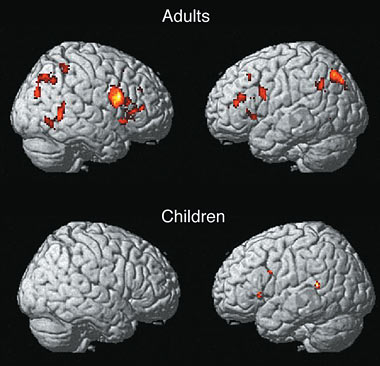WHAT IS THE CRITICAL PERIOD ?
The Critical Period is linked to brain lateralizacion. The human brain is primed to develop language in specific areas of the left hemisphere, but the normal process of brain specialization depends on early and systematic experience with language.
Under ordinary circumstances a child is introduced to language virtually at the moment of birth. Adults talk to him and to each other in his presence. Children do not require explicit language instruction, but they do need exposure to language to develop normally.
The Critical-age hyphethesis asserts that language is biologically based and that the ability to learn a native language develops within a fixed period, from birth to middle childhood. .
WHAT HAPPENS DURING AND AFTER THE CRITICAL PERIOD?
During this Critical period, language acquisition proceeds easily, swiftly, and without external intervention. After this period, the acquisition of grammar is difficult and, for most individuals, never fully achieved. (Children deprived of language during this critical period show atypical patterns of brain lateralization).
Instances of children reared in enviroments of extreme social isolation constitute ¨Experiments in nature¨. for testing the critical-age hypothesis.
 |
| ´´THE WILD BOY OF AVEYRON´´ OF VICTOR. |
The most dramatic cases are those described as ''Wild'' or ''Feral'' children. A celebrated case, documented in Francois Traffaut's film ''The Wild Child'' , is that of Victor, ''The Child Boy of Aveyron'', who was found in 1798. it was ascertained that he had been left im the woods when very young and had somehow survived.
 |
| ''THE FERAL CHILD'' OF GENIE. |
In 1970, a child called Genie in the scientific reports was a discovered. She had been confined to a small room under conditions of physical restraint and had received only minimal human contact from the age of eighteen months until nearly fourteen years. Genie was able to learn a large vocabulary, including colors, shapes. objects, natural categories, and abstract as well as concrete terms.But her grammatical skills never fully developed.
Regardlees of the case of the isolation, none of these children was able to speak or knew any language at time they were reintroduced into society. In the documented cases of Victor And Geniewer, however, these children were unable to acquire grammar even after years of exposur, and despite the ability to learn many words.
Children who are born deaf or become deaf ...

More than 90 percent of children who are born deaf or become deaf before they have acquired language are born to hearing parents. these children have also provided information about the critical age forlanguage adquisition.
Several studies have investigated the acquisition of american sign language at different ages.
The Critical Period of Adults.
Another study compared patterns of lateralization in the brains of adult native speakers of English, Adults native signers and deaf adults who had not been exposed to sign language. the nonsigning deaf adults did not show the same cerebral asymmetries as either the hearing adultsor deaf signers.





No hay comentarios.:
Publicar un comentario